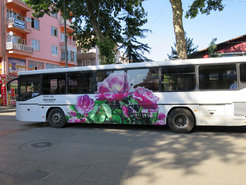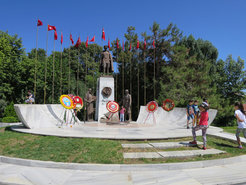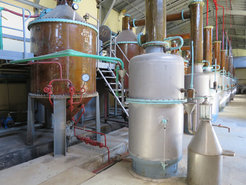The time of the roses and rose oil and their price
Author: Lale Yalçın-Heckmann
May 6, 2016
The time of the roses and rose harvest in the province of Isparta in Turkey is approaching. In fact as last winter was rather mild, some villages have already started the harvest. Isparta is a province in southwest Turkey with a population of over 213 thousand people in the provincial capital in 2012. The province has been known for its oil bearing rose ‘Rosa Damascena’ for over a century. This rose is cultivated primarily for its fragrant oil which is used in cosmetic, perfume, food, medicine and health industries. I started doing research in Isparta in the summer of 2015 where I learned about the processes of producing and preparing the rose oil and its products for the market. Summer is the period when the prices of the rose oil and cultivated roses are formed.
What have roses and rose oil production to do with our project REALEURASIA? The project has multiple conceptual frameworks, including ‘economic ethics’, borrowed from and developed after Max Weber, and ‘moral economy’ , building on the work of historian E.P. Thompson. I apply these frameworks to the rose oil industry. Rose oil firms are mostly middle-sized family enterprises. So far I have been collecting data on both rose cultivators and rose oil producers. In the description that follows, which is based on research in progress, I look also at the meaning attached to Rosa Damascena in the urban space and in urban institutions.
I begin with the latter. Rose oil and other rose products are considered to be a traditional industry, which has given the province a name and branded it. The city is full of the images and symbol of the rose.


Rose cultivation in Isparta is recorded as having started in late Ottoman period. There are diverging narratives as to who initiated rose cultivation within and around the city, but legend makes a certain Ismail Efendi as the honourable patron of rose cultivation and first entrepreneur of rose oil production in the province. The neighbourhood where he is said to have set up the first rose gardens and to have lived is named after him as ‘Rose neighbourhood’ (Gülcü mahallesi), even if within the city no extensive rose gardens remain. The main locations for rose production are the districts around the provincial capital.
Sources cite nearly 10.000 farms (farming households) engaging in rose cultivation in Isparta. These farming households usually cultivate roses in addition to other types of agricultural products and animal husbandry. Baydar and Kazaz (2013: 20) indicate that only 20% of individual farm land is used for rose cultivation and that the average land size for rose cultivation per farm is 0.4 – 0.5 hectare. During the months of May and June roses are picked each day starting around sunrise and lasting for about four-five hours. They should not be harvested after 10 am because the sunbeams warm up the roses and cause the oil to evaporate. After harvesting, the roses should be delivered to the distillation factories as quickly as possible, where they are poured into the cauldrons and mixed with water for distillation. The process is said to take about three hours at most, after which raw rose oil can be collected.

The ratio of roses to rose oil in the production process is crucial: depending on the quality of roses one needs from 2,5 to 4 tons in order to produce one kilogram/litre of rose oil. The productivity of a rose garden, depending on climatic, soil and altitude conditions and other factors, is around 3,5 tons from 0.5 hectare. At harvest time one needs first labourers (e.g. a farming household I talked to, with 3 labouring household members needed another 5 labourers for harvesting ca. 0.2 hectare of rose gardens in summer 2015). Small farmers hence commonly rely on mobilizing their own networks of relatives (primarily young women living in neighbouring towns and cities) and neighbours as labourers for harvesting. Larger farmers and big firms which have bought or rented large fields for rose cultivation, however, find it difficult to recruit adequate number of labourers. Some migrant seasonal labourers from the Southeast of Turkey (mostly Kurds), local Gypsies and finally Syrian refugees who seek employment in the agricultural sector were all mentioned as population groups who might perform this work.
Rose farmers nevertheless emphasize the relatively good conditions for this agrarian production. It is easy to start a rose garden, the climatic and landscape conditions are conducive, and the motivation for engaging in rose production has been increasing. Rose and rose oil production is attractive primarily because of rising prices for both rose producers and rose oil firms. Between 2010 and 2015 the price of rose tripled and the price of rose oil nearly doubled. In the history of rose production in the province however there have been several cases of boom and crash, notably in the early 1990s and 2000s. Given the attractiveness and easiness of rose production, when rose and rose oil prices increased, more roses were cultivated, and the whole cycle crashed due to the over-supply of the world market with rose oil. World market demand is now said to be stable and it is claimed that the province of Isparta supplies 50% of global demand.
Privately owned rose oil firms and the former state cooperative Gülbirlik have different views concerning how to avert a recurrence of boom and bust. The cooperative, which is one of the major actors in rose oil industry, demands state control of production areas and state support for developing the quality of rose cultivation. Private entrepreneurs prefer to emphasise measures to stimulate organic cultivation (as a response to world market changes and demand) and to improve the checks on quality and areas of cultivation for rose production.
Yet there seems to be a considerable degree of mystification concerning price formation and predictions of price and production levels. This is where I see the possibility of engaging with the concept of moral economy. What should the morally legitimate and acceptable price of rose and of rose oil be? How should this be decided and formed? Who should have a say in the formation of prices? Each year the price of roses bought from farmers is determined NOT at the time of harvesting the rose fields (from about mid-May till about mid-June) but after the roses have been processed into rose oil and the oil sold on the world market. The price of rose in 2015 was ‘declared’ at the end of September, i.e. nearly three months after cultivating the roses and producing the rose oil.
The logic and structure of price formation
The discursive narrative on rose production underlines the dependence between productivity and climatic conditions. If the winter has been late, perhaps unusually cold with sudden spells of frost, or if there have not been enough spring time rains, the amount of rose produce may be low and there may be a shortage of petals for the rose oil producing firms. Secondly, there may be chronic shortages of labour at the time of rose collection, as mentioned above; this may cause delays in picking the roses, causing their oil substance to evaporate and the quality to deteriorate. If these two conditions of ecology and labour are fulfilled, the firms produce the oil according to their capacities and available technologies and have in early summer rose oil which they sell primarily to international cosmetic firms. Firms in France, Switzerland, USA, UK and Germany are said to be the most important buyers. The sale of rose oil to these cosmetics firms takes place during the summer months. Companies wait for offers to be made, which the rose oil producers say they do on the basis of the prices from the previous year and their own estimates of overall production levels that year. But these production levels are only estimates and the amount of rose oil actually produced by each company remains a company secret. Experienced producers, of course, know roughly how many tons of roses were cultivated that year and have an approximate idea of the capacity of the firms in Isparta. Nevertheless they wait and try to find out about the price which other companies are offering. During this period of ‘price formation’ there are several guidelines or unwritten rules: 1. the private rose oil firms wait for the Agricultural Cooperative to declare their buying price of rose; 2. they try to understand what the components of that price are (including cooperative membership fee and various kinds of taxes); 3. they offer a price which does not ‘exceed too much’ the price offered by the Coop. The common formulation goes something like this: the cooperative’s price plus 50 Kuruş (similar to cent).
The particularity of this price formation is that there is a good deal of secrecy and ‘mystery’ about it. Upon my questions to what price they will be paying this year, the firm owners or managers expressed great uncertainty: they had a rough idea but it was not a fixed price yet.
The moral economy of rose oil and further thoughts for research
Jane Guyer in her 2009 contribution to the book Market and Society warns us against taking price as the simple mediator between supply and demand. There are good reasons for ‘making explicit’ ethnographically the components of price, and this is pertinent to understanding moral economies. That price veils value has been a long established argument since the time of Marx, and this has been picked up by other anthropologists as well. Julia Elyachar in her work on the public sector and markets in Egypt describes a state employee bureaucrat at a bank who skilfully and with demeanour manages bank loans and access to markets for customers with his “sense (hiss) of the market” (2012: 78). For Elyachar this is skilful employment of tacit knowledge in the sense of philosopher Michael Polanyi (brother of Karl Polanyi, often mentioned in our blogs). It is this kind of tacit knowledge about the veiled components of price making in rose oil industry which I hope to analyse in my further ethnographic work on rose oil production and price making in Isparta.
References
Baydar, H. and S. Kazaz 2013. Yağ Gülü ve Isparta Gülcülüğü. Gülbirlik, Isparta.
Elyachar, J. 2012. “Befrore (and after) neoliberalism: Tacit knowledge, secrets of the trade, and the public sector in Egypt” Cultural Anthropology, 27, 1, pp. 76-96.
Guyer, J. 2009. “Composites, fictions, and risk: toward an ethnography of price” in: Hann, C. And K. Hart (eds.) Market and Society: The Great Transformation Today. CUP, pp. 203-220.


